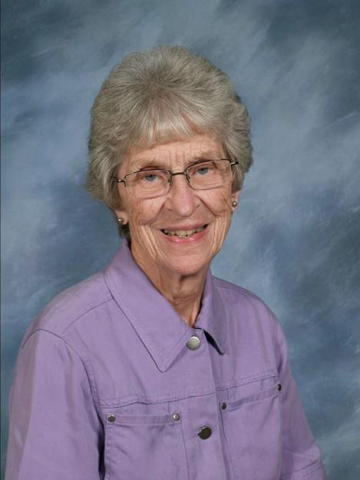Appreciation
Sr. Margaret Brennan, rest in peace.
The death notice on the community's necrology board will read simply: Margaret Brennan, IHM: born Feb. 13, 1924; entered the Servants of the Immaculate Heart of Mary Sisters in Monroe, Michigan in 1945; died April 28, 2016. But it will cover a lifetime of heroic commitment. The work and spirit she left behind her lives on in religious life from one end of the country to the other.
Margaret Brennan's life meant much to many. What she did moved mountains few actually realized at the moment of their turning but which, before the process was over, we all felt.
I can see her yet standing like an oak tree in the middle of a summer storm, unshaken by it all but attuned and moved by every wind.
Most of all, I remember being affected more by what she was than by all the things she was doing, amazing as they were. Her legacy is legion:
The death of Sr. Margaret Brennan leaves a great gaping blank spot in the directory of women religious today. Losing her to the human enterprise and the religious conversations of this age is to lose a thinker, an analyst, a visionary. And yet, what she leaves behind will well outlast the century.
Much will be written about what Sister Margaret did in her lifetime, the positions she filled, the groups she led, the contributions she made to the renewal of religious life in the Catholic church, and so to her place as one of the reformers of the church itself. And they are many. But none of those things, important as they were and life-giving as they still are, is the whole story. And, I think, not even the most important part of the whole story. It's the way Margaret went about doing things that made what she did so powerful, so effective, so foundational.
Margaret Brennan, IHM, served as president of the Leadership Conference of Women Religious, the central organization of elected leaders of women's religious orders in the United States, in the early 1970s, a period of polarization and upheaval. Young women were leaving religious orders in droves. Older women, long years in the orders, either were sinking into anomie or were committed to protest any law, any leader, any attempts to limit the movement of sisters from the Catholic enclave to the streets of cities everywhere, both here and abroad.
Most of all, whatever a sister's private position on particular issues, every position counted toward some kind of polarization. Leadership in those days meant the ability to trust the future as well as to honor the past -- without allowing the past to deter it. Sister Margaret lived and led in the era when criticism came from all sides and nothing was solved by doing nothing. She allowed life to happen so that religious life in all its flavors could be evaluated fairly.
Catholic sisters, in their study of the Scriptures, had discovered that really being Christian was the fundamental Catholic charism. But more than that, in the history of the origins of their orders, they began to realize that they had been too long fenced in against the world around them. Sister Margaret set out early to lead them beyond those fences by bringing religious and social leaders to the national stage, by making the world agenda a religious agenda in every congregation and community in the country.
As one of the first women to earn a doctorate in theology in a church whose study of theology had long been closed to women, her commitment to the sister formation movement and its emphasis on quality education for sister-teachers was legendary. She herself promoted the plan to educate sister theologians in every congregation in the United States. As a result, the professional preparation of nuns made leaping gains and, with it, the value of Catholic education and women theologians everywhere.
Most of all, Sister Margaret, president of a leading missionary order in the United States, as president of the Leadership Conference of Women Religious, opened the minds and souls of women religious to the poor and oppressed everywhere.
But for all those particular passions — globalism, the poor, justice, peace, and the role of women in the church — and all the resistance to them both internally and externally, from clergy and laity alike, Margaret Brennan stood strong. More than that, she stood quietly but firmly grounded in the spirit of Second Vatican Council, which met from October 1962 to December 1965. She honored the tradition, became its center as the two sides pulled it apart, and at the same time encouraged the future, as well.
Most important of all, perhaps, her deep immersion in Jesuit spirituality and centering prayer stressed the most important renewal principle: that religious were to be contemplatives in action. With the Vatican II call to renew religious life, Sister Margaret made it more than social experimentation. Everywhere and at all times, she stressed the relation between the spiritual life of a community and its role in the world.
When women religious leaders themselves moved in two different directions — some committed to change for the sake of tradition, others equally committed to tradition as one of the criteria of change — Margaret refused to exclude anyone. She reached out to conservative factions as well as more liberal ones, seeking dialogue and understanding. And, try as she might, committed as she was to it, she was not successful in a world where bishops themselves were encouraging the division. This inability to help both sides to support and encourage the vision of both by defining one common vision was, she told me, one of the greatest sorrows of her public life.
Through it all, who she herself was as a woman of faith and a committed religious, dominated everything she did and the way she did it. Margaret Brennan was a quiet-spoken woman in an argumentative world whose vision never failed and whose bold steps toward the future never faltered. In the midst of a polarized world, she accepted differences but was loath to allow anything to obstruct unseen possibilities. She thought of theology, her great love, as a guide to the Spirit, not an enemy of the Spirit.
Sr. Margaret Brennan was a resounding personality — strong, centered in the Spirit, and open to a future that would be more than a blind keeper of the past.
In the end, the religious life she loved she enriched, enlivened and left engaged with the world and driven by the Spirit. Indeed, may she rest in peace.
[A Benedictine Sister of Erie, Pennsylvania, Joan Chittister is a best-selling author and well-known international lecturer on topics of justice, peace, human rights, women's issues and contemporary spirituality in the church and in society. She is founder and executive director of Benetvision, a resource for contemporary spirituality. Her From Where I Stand column, is a long-standing online feature of National Catholic Reporter.]
Related - Sr. Margaret Brennan remembered for 'wonderful gift to the whole church'
Sr. Margaret Rita Brennan's leadership has lasting influence for US women religious

